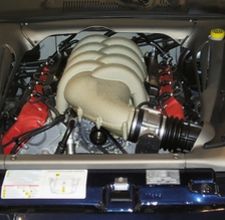There are four main steps involved in setting the timing on a normal engine utilizing a distributor. Setting the timing on an engine synchronizes the spark timing with the engine’s compression stroke for maximum efficiency.
First, pull the vacuum line off of the distributor and plug the end of the line. Next, mark the Top Dead Centre (TDC) mark on the harmonic  balancer (the round piece on the front of the engine) with chalk. In addition, it is a good idea to chalk the correct mark for the number of degrees to which you’ll be setting the distributor. This specification is usually found in the owner’s manual of the vehicle. The third step is to actually use the timing gun. Hook the timing gun up to the battery using the twelve volt alligator clips.
balancer (the round piece on the front of the engine) with chalk. In addition, it is a good idea to chalk the correct mark for the number of degrees to which you’ll be setting the distributor. This specification is usually found in the owner’s manual of the vehicle. The third step is to actually use the timing gun. Hook the timing gun up to the battery using the twelve volt alligator clips.
Additionally, attach the gun to the number one spark plug wire with the wire provided. Usually, a certain engine speed will be designated by the car manufacturer for setting the timing. This specification should also be in the owner’s manual. You may need to enlist the help of a friend to sit in the car with his/her foot on the gas.
With the engine running, point the gun at the harmonic balancer and pull the trigger. If the white chalk lines that you made earlier do not line up, the timing is incorrect. The final step is the adjustment. Loosen the bolt that holds the distributor in place and slightly turn the distributor. Check the timing again and continue adjustments until the timing is correct. Tighten the distributor and remove the timing gun. A correctly timed engine will have increases in performance, economy, and drivability.
